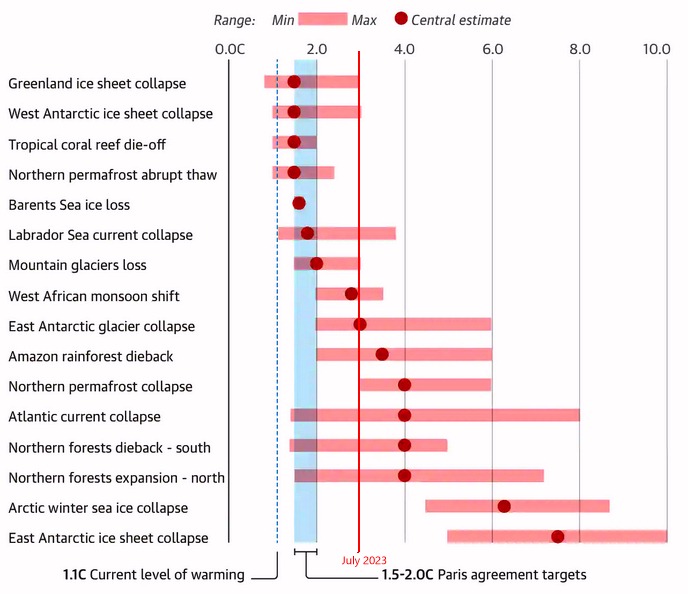
Tipping points are critical thresholds in Earth's climate system that, once crossed, trigger self-reinforcing feedback loops. These loops accelerate warming and destabilize interconnected systems, leading to a cascading domino effect across the cryosphere, oceans, atmosphere, and biosphere.
Recent research confirms that climate tipping points are not isolated but are increasingly interacting. For example, the slowing of the Atlantic Meridional Overturning Circulation (AMOC) is linked to disruptions in the jet stream, intensifying heatwaves, droughts, and flooding across North America and Europe. As AMOC slows due to Greenland meltwater input, it alters atmospheric circulation, causing the jet stream to weaken and meander, which in turn locks weather patterns in place, increasing the likelihood of prolonged heat domes and extreme rainfall events.
The collapse of permafrost and peatlands in the Arctic is further linked to these circulation shifts. As permafrost thaws, vast quantities of CO2 and methane are released, accelerating atmospheric warming. This additional warming feeds back into ice melt in Greenland and the Arctic Ocean, further weakening AMOC and increasing the probability of sudden collapses in regional climates. The jet stream disturbances caused by AMOC weakening also create conditions for intense Arctic warming, amplifying permafrost thaw and the risk of zombie fires in peatlands, which in turn exacerbate carbon emissions.
Simultaneously, Amazon rainforest dieback accelerates under heat and drought conditions intensified by these circulation disruptions, reducing the capacity of one of Earth's largest carbon sinks. This further increases atmospheric CO2, intensifying warming globally, which feeds back into ice melt, AMOC slowing, and further jet stream destabilization. These cascading failures form an interconnected web of tipping cascades, amplifying climate risks beyond linear model projections.
Coral reefs, too, are caught in these cascades, with ocean heating linked to AMOC weakening and atmospheric patterns driving marine heatwaves. As coral reefs bleach and die, the loss of their carbon sequestration functions contributes further to atmospheric CO2 increases, feeding the warming spiral. Meanwhile, violent rain events are increasing in frequency and intensity, driven by the same atmospheric changes. Enhanced hydrological extremes further stress ecosystems, flood coastal carbon sinks, and destabilize soils, creating additional feedbacks of carbon and methane release.
These interacting tipping points are not theoretical risks for the distant future; they are unfolding in real-time and accelerating. The domino effect is a non-linear system collapse that can rapidly transform Earth's climate beyond the capacity for human adaptation, underscoring the urgency to reduce emissions and enhance resilience to protect what remains of a stable climate system.
Our climate model — incorporating complex social-ecological feedback loops within a dynamic, non-linear system — projects that global temperatures could rise by up to 9°C (16.2°F) within this century. This far exceeds earlier estimates, which predicted a 4°C rise over the next thousand years, and signals a dramatic acceleration of warming.
Tipping Cascades: The Nonlinear Dominoes of Climate Collapse Brouse and Mukherjee (2025)
Ignite a Domino Effect: Albedo, Brown Carbon, AMOC, Permafrost, Amazon Rainforest Dieback, Sea Level Rise Pulses, Hydroclimate Whiplash, and Arctic Sea Ice Brouse and Mukherjee (2025)
The Domino Collapse: Amazon Rainforest Dieback and the Ozone Feedback Loop Brouse and Mukherjee (2025)
Where Will Be Safe? The Future of Human Habitation on a Rapidly Collapsing Earth Brouse and Mukherjee (2025)
Solutions to the Fossil Fuel Economy and the Myths Accelerating Climate and Economic Collapse Brouse (2025)
Update on Interactions and Feedbacks Brouse (2025)
Nonlinear Climate Acceleration Confirmed: Heat Deaths Triple from Warming Brouse (2025)
The Converging Collapse: AMOC, Jet Streams, and Deadly Wet-Bulb Temperatures Brouse (2025)
Canadian Wildfires: Over the Tipping Point Brouse (2024)
Coral Reefs' Tipping Point Brouse (2024)
East Coast Atmospheric Rivers and AMOC (Atlantic Meridional Overturning Circulation) Brouse (2024)
Climate Change, the Jet Stream, and East Coast Atmospheric Rivers Brouse (2024)
Wildfires Brouse and Mukherjee (2024)